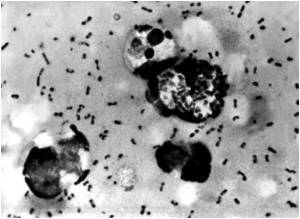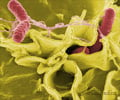The mechanism by which the human body cells recognize salmonella bacteria and render it harmless have been found by Goethe University researchers.

Salmonella infection is known to begin with bacteria entering the epithelial cells of the intestinal mucosa. To prevent them from multiplying, special cell organelles called autophagosomes are activated.
These encircle the invaders and then become absorbed in other organelles called lysosomes containing certain special digestive enzymes, which break down the bacteria into their constituent parts.
However, the study explains how autophagosomes recognize salmonella bacteria.
The salmonella are marked as 'waste material' by the molecule ubiquitin. For the autophagosomes to become active, the marked bacteria have to bind to another molecule - LC3 - on the autophagosomal membrane.
Here, the protein optineurin links the marked Salmonella to the autophagosmal LC3, thereby setting off a process of selective autophagy.
Advertisement
The study appears in the scientific journal "Science".
Advertisement










